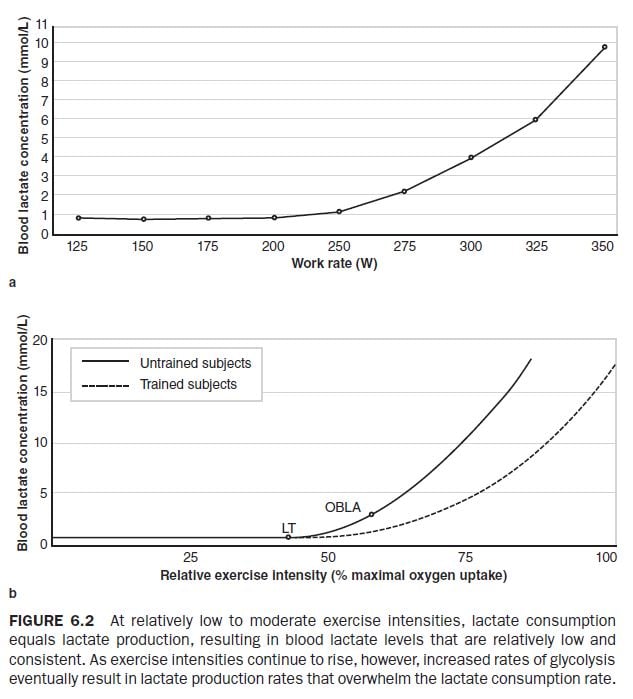Performing a Lactate Threshold Test
by NSCA's Guide to Tests and Assessments
Kinetic Select
January 2020
This excerpt from NSCA's Guide to Tests and Assessments briefly discusses the method behind a lactate threshold test and the pretest considerations one might take prior to this test.
The following is an exclusive excerpt from the book NSCA's Guide to Tests and Assessments, published by Human Kinetics. All text and images provided by Human Kinetics.
During a lactate threshold test, subjects exercise at progressively higher work rates until they are at or near exhaustion. Blood samples are taken at regular time intervals throughout the test and analyzed for lactate concentration. The test begins at a relatively low work rate and progresses slowly so that blood lactate levels remain at, or near, resting levels throughout the early stages of the test. The work rate increases such that a lactate threshold is reached after approximately 12 to 20 minutes of exercise. This strategy of gradually increasing the workload from a low-intensity starting point establishes an exercising baseline level of blood lactate that is useful in identifying the point at which blood lactate accumulation begins.
A variety of exercising modes can be used to perform a lactate threshold test; treadmill running and cycling ergometry are two of the most popular. Although practically any exercise mode is suitable for testing non-endurance-trained athletes, endurance-trained athletes should be tested using the type of exercise that most closely resembles their competitive events. This strategy allows the athlete to perform the test using a familiar mode of exercise and provides data that are useful in both the design and the assessment of a training program.
Pretest Considerations
Prior to the start of a lactate threshold test, the subject should perform an adequate warm-up of approximately 10 to 15 minutes beginning at a low work rate and progressing to a terminal intensity that is similar to the starting work rate for the lactate threshold test. The warm-up serves two purposes:
- The oxidative energy pathways need several minutes to reach optimal operating capacity. Early in exercise, the body relies heavily on glycolysis to meet ATP demand, resulting in high levels of lactate production. This increased rate of lactate production could lead to blood lactate levels in the initial stages of the test that may not accurately reflect the blood lactate production and consumption dynamics when mitochondria are functioning at their optimal levels.
- People who have never had a lactate threshold test may be apprehensive or nervous before the test begins. These feelings may result in a rise in circulating levels of epinephrine, which can cause increased rates of glycolysis and lactate production. In fact, epinephrine is such a potent stimulator of lactate production that anxious, but otherwise resting, subjects can exhibit blood lactate levels similar to those undergoing intense exercise. These uncharacteristically high levels of blood lactate can make it more difficult to determine the point at which lactate production begins to accelerate as a result of increases in work rate, leading to an inaccurate assessment of lactate threshold. By performing a warm-up prior to the start of the lactate threshold test, subjects can reduce anxiousness and their rates of lactate production, leading to more accurate lactate levels during the early portion of the test.
Starting work rates and the progression of the work rates over the course of the test are dictated by the ability of the subject. Care should be taken when establishing these values to ensure that the subject reaches lactate threshold within approximately 12 to 20 minutes. A test that starts at too high of a work rate or progresses too quickly may not allow the subject to establish an exercising baseline, making identification of the lactate threshold difficult or impossible. A test that starts too low or progresses too slowly wastes both time and materials. Current training paces and previous lactate threshold results can be useful in determining proper starting work rates. If the subject has no prior exercise experience, it is best to err on the conservative side; otherwise, the examiner runs the risk of having to repeat the test because the starting work rate exceeded the subject’s lactate threshold work rate or the examiner did not allow for the establishment of an exercise baseline.

Description: At relatively low to moderate exercise intensities, lactate consumption equals lactate production, resulting in blood lactate levels that are relatively low and consistent. As exercise intensities continue to rise, however, increased rates of glycolysis eventually result in lactate production rates that overwhelm the lactate consumption rate.
Developed by the National Strength and Conditioning Association (NSCA), this comprehensive text offers extensive information on performance-related assessment and testing for strength and conditioning professionals in measuring key fitness components. The book is available in bookstores everywhere, as well as online at the NSCA Store.
- Privacy Policy
- Your Privacy Choices
- Terms of Use
- Retraction and Correction Policy
- © 2025 National Strength and Conditioning Association